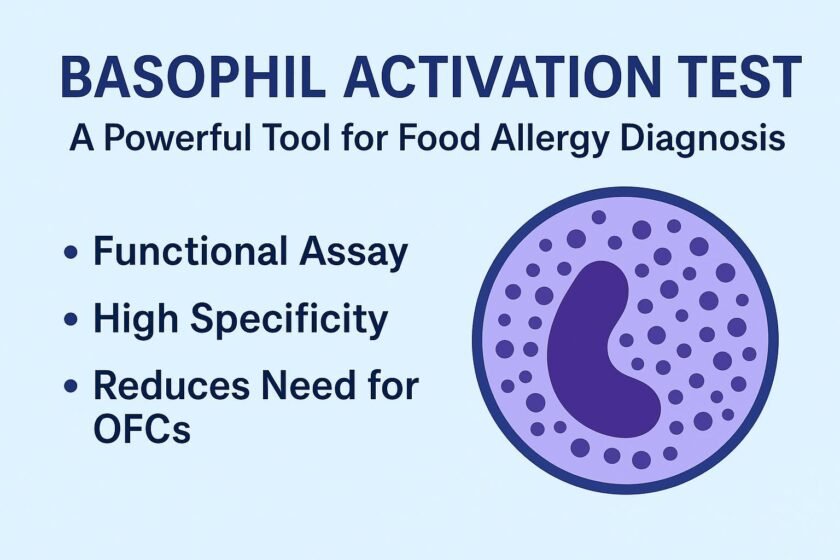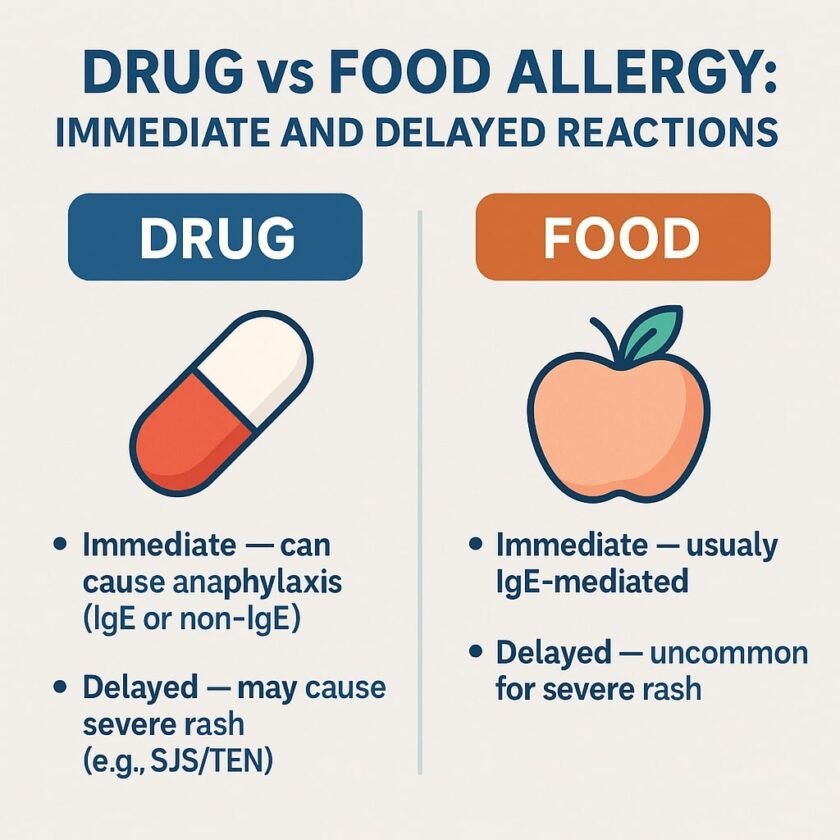Diagnosing food allergies accurately remains one of the biggest challenges in allergy medicine. Traditional approaches like skin prick tests (SPT) and specific IgE blood tests can tell us if someone is sensitized to a food, but they don’t always predict whether that person will actually have an allergic reaction. Meanwhile, oral food challenges (OFCs)—the gold standard—are time-consuming, expensive, and carry real risks of severe reactions.
Enter the Basophil Activation Test (BAT): a revolutionary diagnostic tool that’s changing how we approach food allergy diagnosis.
🧪 What Makes BAT Different?
BAT is a functional laboratory test that measures how your immune system’s basophils (a type of white blood cell) actually respond when exposed to specific allergens. Using sophisticated flow cytometry technology, the test detects activation markers like CD63 and CD203c on basophil surfaces—essentially watching your immune cells “light up” in real-time when they encounter an allergen.
The key advantage? BAT has emerged as a new diagnostic test for food allergy with high diagnostic accuracy, and unlike food challenges, it’s performed safely in a test tube with no risk of allergic reactions to the patient.

📊 The Science Behind BAT’s Accuracy
Recent research has demonstrated impressive results for BAT across multiple food allergies:
- Peanut and tree nuts: BAT can predict allergic clinical status to peanut and tree nuts in multi-nut-sensitized children and may reduce the need for high-risk OFCs in patients
- Egg allergy: Using BAT and component testing (Gal d 1-specific IgE), separately or in combination, may reduce the need for oral food challenges in children with egg allergy
- Milk allergy: BAT was statistically significantly correlated with sIgE, and the diagnostic performance increased when sIgE was combined with the BAT when testing for milk allergy
- Multiple allergens: BAT has shown capability to discriminate between allergic and nonallergic children for peanut, hazelnut, cashew nut, sesame, and almond
🎯 When Should You Consider BAT?
BAT is particularly valuable in these clinical scenarios:
🔍 Diagnostic Uncertainty
- When your clinical history doesn’t match your skin test or IgE results
- In cases where you’re sensitized to multiple foods but unclear which ones cause actual reactions
- When component testing (molecular allergy diagnostics) results are inconclusive
⚠️ High-Risk Situations
- When oral food challenges are too risky due to severe reaction history
- In patients with multiple food allergies where systematic testing is needed
- For elderly patients or those with skin conditions that make skin testing unreliable
💊 Treatment Monitoring
- Tracking progress during oral immunotherapy
- Assessing whether tolerance is developing over time
- In patients who cannot stop antihistamines, making skin tests unreliable
🚧 Important Limitations to Know
While BAT is powerful, it’s not perfect for everyone:
- Non-responders: About 10% of patients have basophils that don’t respond to any stimulation, making results uninterpretable
- Low basophil counts: Patients on certain medications (like systemic steroids) or with specific medical conditions may not have enough basophils for accurate testing
- Specific to IgE reactions: BAT only works for IgE-mediated allergies- it can’t diagnose conditions like FPIES or eosinophilic disorders
🆚 How BAT Compares to Other Tests
BAT vs. Oral Food Challenge
| Feature | BAT | OFC |
| Safety | No reaction risk | Risk of severe reactions |
| Convenience | Simple blood test | Time-intensive, requires medical supervision |
| Accuracy | High specificity | Gold standard when completed |
| Cost | Laboratory fee | Expensive due to time and resources |
| Best Use | When OFC is risky or unavailable | When absolute confirmation needed |
BAT vs. Traditional Tests (SPT/IgE)
The crucial difference: SPT and IgE tests only show sensitization, while BAT shows functional reactivity. You can be sensitized to a food without being clinically allergic – but a positive BAT suggests your immune system is primed to react.
🥜 Which Food Allergies Benefit Most from BAT?
Based on current research evidence:
| Food Allergen | Evidence Quality | Clinical Impact |
| Peanut | ⭐⭐⭐⭐⭐ | Excellent accuracy, significantly reduces need for food challenges |
| Tree nuts | ⭐⭐⭐⭐ | Well-validated for cashew, hazelnut, almond, and others |
| Sesame | ⭐⭐⭐⭐ | Particularly useful for distinguishing allergy from sensitization |
| Egg | ⭐⭐⭐⭐ | Strong evidence for reducing need for food challenges, especially when combined with component testing |
| Cow’s milk | ⭐⭐⭐⭐ | Effective for IgE-mediated milk allergy diagnosis, particularly in children |
| Wheat, soy, shellfish | ⭐⭐ | Emerging evidence, more research needed |
🎯 The Bottom Line
A flawless test to confirm or rule out a food allergy does not exist, but BAT represents a significant advance in allergy diagnosis. For the right patients, it can:
- Reduce unnecessary food challenges by providing functional evidence of allergy
- Improve safety by avoiding risky oral exposures in high-risk patients
- Enhance diagnostic confidence when traditional tests are inconclusive
- Monitor treatment progress during immunotherapy
The key is working with an experienced allergist who understands when BAT is most helpful and how to interpret results in the context of your individual history and other test results.
💡 Key Takeaway: BAT doesn’t replace traditional allergy testing – it complements it. Think of it as adding a powerful new tool to your allergist’s diagnostic toolkit, especially valuable when standard approaches leave questions unanswered.
Important Note: BAT is only applicable to IgE-mediated food allergies. It cannot diagnose non-IgE-mediated food reactions like FPIES (Food Protein-Induced Enterocolitis Syndrome) or eosinophilic gastrointestinal disorders.
📚 References
This information is for educational purposes only and should not replace professional medical advice. Always consult with a qualified allergist for personalized diagnosis and treatment recommendations.




